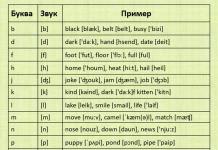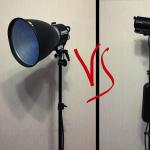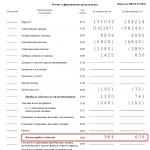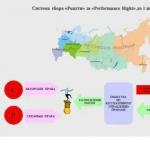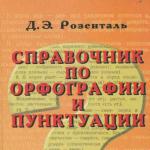The English alphabet is based on the Latin alphabet and consists of 26 letters. Of these, 6 are vowels: A, E, I, O, U, Y.
20 consonants: B, C, D, F, G, H, J, K, L, M, N, P, Q, R, S, T, V, W, X, Z
The letter "Y" can convey both a vowel and a consonant. In combination with a vowel, the pronunciation is very close to Russian [th] and denotes the sounds [j] or [y]
yellow, yes, you, yard, young, yoga, yogurt
day, they, boy, toy, buy, eye
Forming syllables and being paired with a consonant, the letter “Y” conveys the vowel sound [i]
baby, mystery, system, funny
and sound [ai] in words
my, cry, analyze, cycle, sky, reply
In the alphabet, each letter has its own sound name, i.e. alphabetical reading.
Transcription signs are used to convey sounds in writing. Each sign corresponds to only one sound inherent to it. Transcription signs are written in square brackets: for example, the letter A and its alphabetical name (sound) is [ei].
In the alphabet, the letters are read unambiguously, one letter - one sound.
The letters Z and R are read differently in the British and American versions.
The British version of Z is (zed), the American version of Z is (zi).
The British version of R is (a), the American version of R is (ar).
Knowledge of the English alphabet is also necessary due to the discrepancy between the pronunciation of words and their spelling. Therefore, you may often be asked to repeat a word by letter - Can you spell that, please?
English alphabet with pronunciation and transcription
| Letter | Transcription | Pronunciation* | The sounds it conveys | |
| A a | Hey | , [æ] | ||
| Bb | bi | [b] | ||
| C c | si | [s] - before e, i, y [k] - in other cases |
||
| D d | di | [d] | ||
| E e | And | ,[e] | ||
| F f | ef | [f] | ||
| G g | ji | , [g] | ||
| H h | HH | [h] | ||
| I i | ah | ,[i] | ||
| Jj | Jay | |||
| K k | Kay | [k] | ||
| Ll | el | [l] | ||
| Mm | Em | [m] | ||
| Nn | en | [n] | ||
| O o | OU | , [ɔ] | ||
| P p | pi | [p] | ||
| Q q | Cue | |||
| R r | ar | [r] | ||
| Ss | es | [s], [z] | ||
| T t | you | [t] | ||
| U u | Yu | , [ʌ], [u] | ||
| V v | in and | [v] | ||
| W w | ["dʌbl ju:] | double u | [w] | |
| X x | the ex | , | ||
| Y y | wy | [j] | ||
| Z z | () | zi (zed) | [z] | |
* In the column " Pronunciation"Given in Russian letters the approximate sound of the letter names. And in the column " Transcription" a more accurate pronunciation is given using phonetic transcription.
When you study a foreign language, you learn not only a set of vocabulary and grammar, you in any case come across the culture and mentality of the people who speak this language. The best means of learning language and culture is reading in original. And to read in a foreign language, you must first learn to read this language .
You don"t have to burn books to destroy a culture. Just get people to stop reading them.
You don't have to burn books to destroy a culture. You can just make people stop reading them.
But, if at school or university you studied German or French, or your school base turned out to be smaller than you would like, and now you have decided to learn English, then let's start with the most primary and basic and find out several methods of where to start in order to master reading rules.
English alphabet
I think you know that English is different from Russian and German, in which we mainly write and read. In English the system is a little more complicated. The very first thing we need to do is learn the alphabet.
There are 26 letters in the English alphabet, including 21 consonants and 5 vowels. Knowledge of letters and the ability to pronounce them correctly is the key to successful and competent reading in English.
English alphabet with transcription of letter names.
A very easy way to memorize letters visually and aurally is with the help of a song. Watch the video and sing the song until you remember the letters of the alphabet.
You can use the same method to teach the alphabet to your children and sing the song with your kids.
Reading rules in English
After studying the alphabet, we will begin to study the combination of letters and read short words. There are a number of rules in the English language that you need to learn, practice and remember if you want to read English words correctly.
Rules for reading English consonants
Many consonants are read similarly to Russian consonants, for example the letters m, n, l, b, f, z. You can see this in words like mom, lemon, finger, boy, zebra .
Letters like t And d sound similar, but pronounced with aspirated. For example words table, teacher, dad, dirty.
Letter c has two reading options. Before letters i,e,y it reads like [s]- city, face, cyber. And before other vowels it is read as [k]- cat, cake, factory.
Rule with vowels i,e,y also works with letters g. In front of them it reads like - gym, George, giant. Before other consonants the letter is read as [g].
Letter q always occurs in a combination of letters qu and reads like - quick, queen, square.
Letter j always reads like - jacket, jam, joy.
 Table of the relationship between consonants and sounds in English.
Table of the relationship between consonants and sounds in English.
How to read vowels in English
In English, a word can end in an open or closed syllable, which affects pronunciation. For example words cat, pot, sit end in a closed syllable and have vowels a, o, i give sounds .
Words such as name, home, five end with an open syllable, since there is a letter at the end of the word e, which is not readable. But, thanks to her, the vowels in the middle of the word are read exactly the same way as they are pronounced in the alphabet, that is, the word name read .
 Types of reading English vowels in stressed syllables.
Types of reading English vowels in stressed syllables.
Reading vowel combinations in English
There are certain combinations of letters that have established reading rules, although English is a language of exceptions, and when reading more complex words you should consult a dictionary. The table below shows combinations of English vowels with examples how they are read and what sound they make.
 Table of vowel combinations in English.
Table of vowel combinations in English.
And of course, there are exceptions to all rules. However, don't worry and think that you will never be able to learn it. Everything can be understood, you just need to try and practice a little.
Diphthongs of the English language with transcription
When you study the basic rules of reading, you will see that in English there are diphthong sounds that are quite difficult to reproduce, especially if you start learning the language not in childhood, but in adulthood.
 Table of English diphthongs with transcription.
Table of English diphthongs with transcription.
Transcription of sounds in English
Practice shows that when children learn a language, they must definitely study transcription, but adults do not want to learn it and it can be difficult for them.
If you still want to learn how to write and read transcriptions, then great! And if not, then you can use online dictionaries, where the word will be pronounced for you. One of the best dictionaries today is Multitran and the online dictionary Lingvo.
Important!
Remember that you need to use dictionaries, not translators!
Here is an example of reading short words with transcription:
 Table of vowel sounds in English and transcription.
Table of vowel sounds in English and transcription.
Living in the Internet age has some advantages. While sitting at home, you can master various knowledge online. For your attention video lesson, which explains the basic principles of reading. However, even after gaining knowledge through an online lesson, it needs to be consolidated in order for a skill to be formed.
Learn English tongue twisters
Tongue twisters, which are often aimed at practicing one sound, can help you here. Here are some examples you can use.
| Tongue twister in English | Translation into Russian |
|---|---|
| Whether the weather be fine, or whether the weather will not. Whether the weather be cold, or whether the weather be hot. We"ll weather the weather whether we like it or not. |
The weather will be good or the weather won't be good. The weather will be cold or the weather will be hot. We can withstand any weather whether we like it or not. |
| Three swiss witch-bitches, which wished to be switched swiss witch-bitches, watch three swiss Swatch watch switches. Which swiss witch-bitch", which wishes to be a switched swiss witch-bitch, wishes to watch which Swiss Swatch switch? |
Three Swiss witch bitches those who want to change their gender, looking at the three buttons on the Swatch watch. What a Swiss witch bitch those who want to change their gender, looking at what button on the Swatch watch? |
Don't worry about tongue twisters! At this stage, when you are just learning to read and practicing sounds, it is important to pronounce them correctly, albeit slowly. You can always speed up.
Learn to hear English speech
After learning the basic, basic rules of reading, you can use the method of repeating after the speaker. Your auditory memory will also work and you will hear how words are pronounced correctly and what intonation is in sentences.
For this, you can use short dialogues and audio books for beginners. At this level, it would be ideal if the text is in front of your eyes, you listen, read and repeat at the same time!
You can use such a great resource as Oxford bookworm Library, which features audiobooks for all levels. You can download the library for free
For those who continue to learn English, we recommend learning the language from films, which you can read about in the article
Work on your pronunciation
Learning to read is only the first step towards learning a language. Just like learning grammar and vocabulary, learning to pronounce and hear correctly is very important if you want to understand what is being said to you and say it so that you are understood. Especially if you speak with a native speaker.
As we said a little above, one of the best ways is listen carefully to native speakers and try to copy their pronunciation and intonation .
Particular attention should be paid to sounds that do not exist in your native language. Often, people learning English have a problem with the ‘r’ sound, since in Russian it is hard, but in English it is more guttural and growling.
There are also difficulties in pronouncing the two sounds that combination of letters 'th'. Students persistently pronounce it as ‘c’ and ‘z’. Although it is worth noting that in words such as this, that, there, this sound is spoken as between ‘z’ and ‘d’. And in words like three, think, thief, it is pronounced as a sound between ‘f’ and ‘s’.
This may seem strange to you, since there are no such sounds in the Russian language, but if you listen to native speakers, you will understand that this is how they speak.
Don't worry if you can't say these words correctly the first time, it just takes a little practice. But, try to learn correctly from the very beginning, because it will be more difficult when you are forced to relearn.
Learn to pronounce phrases in English correctly
In English, words in sentences are not pronounced separately; they often merge as if into one whole, especially if it is a combination of a vowel and a consonant. Watch and practice with these transcription examples.
The same applies to phrases where one word ends with the letter ‘r’, and the next word begins with a vowel. In such cases, the sound 'r' is pronounced. Here are some examples.
Transcription is the transmission in writing of elements of oral speech using a certain set of written characters. Phonetic transcription– this is the most accurate transmission of oral speech by graphic means (special transcription signs).
Each individual sound and its variants have their own designations. For recording, special characters are used, called transcription marks, which are enclosed in square brackets. Some of these signs repeat the letters of the English alphabet; the designations of others may differ significantly. However, a letter and a sound are completely different things. Letter- these are designations of sound in writing, while sound can be regarded as an independent unit. We write and read letters, we hear and pronounce sounds. The transcription sign indicates the sound and the features of its pronunciation. In writing, one letter can convey several sounds at once, and each transcription sign can convey only one sound.
What is transcription used for?
The spelling of a word and its actual pronunciation may vary significantly. Therefore, for correct pronunciation, only knowledge of the reading rules is not enough, because there are always exceptions to the rules. The same letters/letter combinations under the same conditions can be read differently. Thanks to transcription, if necessary, you will be able to correctly read an unfamiliar word. At the initial stage of learning a language, it is possible to use Russian transcription, but in the English language there are sounds that are absent in the Russian language, so Russian transcription conveys only the approximate sound of a word, which is why you may pronounce a word written in Russian transcription incorrectly. In addition, the quality of pronunciation of the same sounds may differ.
Perfect knowledge of transcription signs is not necessary, because it is unlikely that you will need to convey the sound of a word using these signs. But you may need to look up the correct pronunciation of the word in a dictionary. And for this it is important to be able to correctly read the transcription in the dictionary. In addition, most transcription signs are found in other European languages.
Factors affecting pronunciation
Word stress
The correct pronunciation of vowels in stressed syllables, where vowels are pronounced clearly, and the meaning of the word will depend on the correctness of their sound, can cause difficulties. In an unstressed syllable, vowels are not clearly articulated and may fall out (not be pronounced), so they do not pose any particular difficulties in pronunciation. Unlike the Russian language, where the stress is placed above the stressed syllable, in English the stress is indicated by a vertical stroke before stressed syllable. Monosyllabic words have one stress, long ones can have two. In this case, the main stress is placed at the top, the secondary stress is at the bottom.
English sounds
Consonant sounds and their approximate Russian analogues:
- [b] - [b]
- [d] - [d]
- [f] – [f]
- [g] - [g]
- [k] -[k]
- [l] - [l]
- [m] -[m]
- [n] - [n]
- [p] - [p]
- [s] - [s]
- [t] - [t]
- [v] - [v]
- [z] - [z]
- [ʃ] - [w]
- [ʒ] – soft [zh]
- - [h]
- – absent in the Russian language (represents a very quickly pronounced sound [j]);
- [r] – the tip of the tongue is not tense, does not vibrate, is motionless, raised to the roof of the oral cavity, but does not touch the alveoli (reminiscent of the Russian sound [r], but not as clear);
- [j] - [th];
- [ŋ] – nasal [n];
- [θ] – absent in Russian, interdental (to pronounce it, pronounce [s], sticking the tip of your tongue between your teeth);
- [ð] - absent in Russian, interdental (to pronounce it, pronounce [z], sticking the tip of your tongue between your teeth).
The articulation of a number of English sounds is practically no different from the articulation of Russian sounds, but there are some features:
- English [t], [p], [k] are distinguished from their Russian counterparts [t], [p], [k] by their pronunciation with aspiration (aspiration);
- When pronouncing sounds [d], [l], [n], [t], the tip of the tongue is on the alveoli (tubercles just above the upper teeth);
- [ʃ] [ʒ] – softer than their Russian counterparts, for this you need to slightly raise the back of the tongue;
- [h] – the sound is slightly louder than an exhalation;
- [w] – lips are rounded and tense, the lower lip should not touch the teeth (quickly say [ui]).

Pronunciation of vowels
In English, vowel length is very important because it affects the meaning of a word. This means that words with the same vowel of different lengths will differ in meaning, for example: sheep [ʃi:p] - sheep, ship [ʃɪp] - ship, live live - leave - leave, leave.

The length of a vowel in writing is indicated by two dots after it. With 6 vowel letters you can form a wide variety of sounds:
- – long sound [a];
- [æ] - average between [a] and [e], the mouth is wide open, the jaw is lowered down;
- - long [and];
- [i] - short [and];
- [e] – average between [e] and [e], the corners of the lips are stretched to the sides;
- [ɔ] - short [o];
- [ɔ:] - long [o];
- [ə] - unclear, unstressed sound, reminiscent of [e];
- [ʌ] – short [a];
- [z] - resembles the sound [ё];
- [u] - short [y];
- - lingering [y].
Diphthongs
Diphthongs- these are two vowel sounds pronounced together, where the first is stressed, articulated more clearly and clearly, and the second is weaker:
- - [ay];
- - [Hey];
- [ɔi] - [oh];
- - [ay];
- [əu] - [оу];
- - [ie];
- - [ue];
- [ɛə] - vaguely similar to [ea].

Thrifthongs
Triphthong is a combination of three vowel sounds that are pronounced together and are part of one syllable.
- pronounced [aye]. The longest of the three sounds is “a”. The sounds “y” and “e” are pronounced almost simultaneously.
In writing it is expressed using the letter combinations “ire”, “yre”, “iar”, less often “ier” and “ie+t”:
ire - fire [‘faɪə] (fire)
yre - tire [‘taɪə] (tire)
iar - liar [‘laɪə] (liar)
ier - tier [‘taɪə] (binding)
iet - quiet [‘kwaɪət] (quiet)
- pronounced [aue]. In this case, the sound “u” is exactly the sound that is conveyed by the letter “w”.
In writing it is conveyed using the letter combinations “our”, “ower”:
our - sour [‘sauə] (sour)
ower - power [‘pauə] (strength)
- pronounced [yue]. The longest of the three sounds in this triphthong is "u".
In writing it is conveyed using the letter combinations “eur”, “ure”:
eur - European [ˌjuərə’piːən] (European)
ure - pure (clean).
Words in a stream of speech
In addition to the main stress, with the help of which emphasis is placed on a syllable, there is the concept of phrasal stress. Phrase stress- this is the selection in the flow of speech of words on the importance of which the speaker wants to emphasize. The placement of phrasal stress does not significantly change the essence of the sentence. Let's compare using the example of a simple short sentence (emphasis added in bold:) She has gone to the shop just now. She just went to the store (it was she, not someone else). She has gone to the shop just now. She had just gone to the store (walked, not used another means of transportation). She has gone to the shop just now. She just went to the store (namely the store, and not anywhere else). She has gone to the shop just now. She just went to the store (just now).

Accordingly, the stressed word will be pronounced as clearly as possible. As a rule, function words are prepositions, conjunctions, particles, pronouns, etc. are in an unstressed position. It should also be noted that colloquial speech tends to be minimized: it is characterized by the use of abbreviated forms, less clear articulation, sometimes deliberate mispronunciation of words, loss of vowels, etc.
How much time to devote to practice?
The answer is obvious. The more practice in the language, the better. The more time you spend practicing your pronunciation, the more authentic (more natural, as similar to English speech as possible) your speech will sound. Listening to English speech, imitating it, reading aloud will help you with this. Record your speech on a voice recorder, which will help you identify your own mistakes, because your perception of your own speech differs from its perception by others. And remember that when learning a foreign language, regularity of classes is extremely important. With shorter, but regular exercises, you will achieve greater results than with long, “jerky” exercises. We wish you success!
 English alphabet with transcription
English alphabet with transcription
 Reading rules in English
Reading rules in English
English Transcription is a sequence of phonetic symbols that helps us understand how to read a particular sound or word. The concept of transcription is quite difficult for Russian speakers to understand, because In our language, although such a category exists, it is used extremely rarely.
Why is transcription needed?
The phonetics of the English language has a noticeable feature: historically, words are often read differently from how they are written, that is, from the spelling of a word it is not always possible to guess how it is pronounced. Of course, there are general ones, but there are still plenty of exceptions. For example, there are a large number of words that have either unreadable or readable letters depending on the environment. And the rules themselves are difficult for schoolchildren to remember. Therefore, in almost any dictionary, after writing an English word in square brackets, its reading in transcription symbols is given.
Often, schoolchildren and students encounter transcription at the beginning of learning a language, when it is still quite difficult to read even fairly simple words. Then, as you study the transcription signs, it becomes easier and easier to perceive the contents of the square brackets.
How are transcription signs read?
In the English pronunciation system there are 48 sounds, therefore, there are 48 transcription signs. Let's look at their pronunciation depending on the letters of the English alphabet that represent them.
| Letter | Designation in transcription |
Sounds | Example |
|---|---|---|---|
| More sounds
[θ] – soft letter (c), the tongue is located between the front teeth of the upper and lower jaw Accent icon- if a word with more than one syllable is transcribed, the stress must be indicated with an apostrophe (comma at the top). It is placed before the stressed syllable. For example: - decision. |
|||
| Aa | Sounds like Russian (hey) | p a ge — [p eɪdʒ] - page | |
| [æ] | Middle sound between (e) and (a) | b a nk — [b æŋk] - bank | |
| [ɑː] | Similar to long Russian (a) | c a r — [k ɑː ] — a car | |
| [ɔː] | Long sound (oh) | h a ll — [h ɔːl] - hall, hall | |
| Bb | [b] | Almost like a Russian sound (b) | b e d — [b e d] — bed, bed |
| Cc | [k] | similar to Russian sound (k) | c amera — [ˈk am(ə)rə] — camera, camera |
| [s] | similar to Russian sound (c) | bi c ycle — [ˈbʌɪ sɪk(ə)l] - bike | |
| [ʃ] | The middle sound is between (w) and (w). | o c ean — [ˈəʊ ʃ(ə)n] - ocean | |
| Dd | [d] | How (d), pronounced with the tongue positioned at the gums | d id — [dɪd] - did |
| Ee | Long sound(s) | sh e — [ʃ i] - she | |
| [ɪ] | And | z e ro — [ˈz ɪərəʊ] - zero, zero | |
| [e] | Reminds the sound (e) with a tint (e) | t e n — [t e n] - ten | |
| [ɜː] | Similar to the sound (е) in words m e d, l yo n. | f ern — [f ɜːn] - fern | |
| Ff | [f] | How (ph). | f our — [f ɔː] - four |
| Gg | [g] | Similar to Russian (g). | g ot — [ˈɡɒt] - receive |
| Hh | [h] | Short exhale (x). | h ow — [ˈh aʊ] — how, in what way |
| II | Similar to Russian sound (ay) | f I've — [f aɪ v] - five | |
| [ɪ] | Similar to Russian (и) with a slight connotation (ы) и (е), as in the word outside And | l i little — [ˈl ɪ t(ə)l] - small | |
| [ɜː] | Similar to the sound (е) in words m e d, l yo n. | g i rl — [ɡ ɜːl] — girl, girl | |
| Long sound(s) | mach i ne — [məˈʃ i ːn] — machine, mechanism | ||
| Jj | Similar to (j) | journey — [ˈdʒ əːni] - journey | |
| Kk | [k] | Like the sound (k) | k ind — [k aɪnd] - species, genus |
| Ll | [l] | How (l), pronounced with the tongue positioned at the gums | l eg — [l eɡ] - leg, leg |
| mm | [m] | As M) | m an — [m æn] - man |
| Nn | [n] | How(n) | no — [nəʊ] - No |
| Oo | [əʊ] | Similar to the sound (oh) | m o st — [m əʊst] — majority, greatest |
| [ɔː] | Long sound (oh) | m o re — [m ɔː ] - more, more | |
| [ɒ] | A short sound that sounds similar to both (o) and (a) at the same time. | n o t — [n ɒt] - not no | |
| Long (y) without rounding the lips. | wh o — [h uː] - Who | ||
| [ʊ] | Looks like a short one | g oo d — [ɡ ʊd] - good, kind | |
| [ʌ] | c o me — [k ʌ m] — come, come | ||
| [ɜː] | Similar to the sound (е) in words m e d, l yo n. | w o rk — [ˈw ɜːk] - Job | |
| Pp | [p] | Similar to Russian (n). | p en — [p en] - pen |
| [k] | Looks like Russian(k). | head q uarters — [hɛdˈ k wɔːtəz] - headquarters, center | |
| Rr | [r] | Like Russian (r) without vibration. | r ed — [r ed] - red |
| Ss | [s] | Looks like Russian (c). | s o — [ˈs əʊ] — so, thus |
| Tt | [t] | Looks like Russian (t), pronounced with the tongue positioned at the gums | t ea — [t iː] - tea |
| Uu | [ʊ] | Looks like a short one | p u t — [ˈp ʊ t] — put, put, put |
| [ʌ] | Reminds me of an indistinct short sound (a) | c u t — [k ʌ t] - cut, incision | |
| Long (u) | t u ne — [t juː n] — melody, tune, customize | ||
| [ɪ] | Similar to Russian (и) with a slight connotation (ы) и (е), as in the word outside And | b u sy — [ˈb ɪ zi] — busy, busy | |
| [ɜː] | Similar to the sound (е) in words m e d, l yo n. | t urn — [t ɜːn] — turn, turn around | |
| Vv | [v] | Similar to the sound (v) | v ery — [ˈv eri] - very much |
| Ww | [w] | A sound similar to (y) lips stretching and rounding. | w orld — [w əːld] - world |
| Xx | similar to the sound (ks) | X-ray — [ˈe ks reɪ] — X-ray | |
| [z] | similar to Russian sound (z) | X erox — [ˈz ɪərɒks] — copier | |
| Yy | Like (ay) in the word m ah | b y — [b aɪ] - on, on, to, at | |
| [j] | Looks like a weak Russian - (th) | y es — [jes] - yes, consent | |
| [ɪ] | Similar to Russian (и) with a slight connotation (ы) и (е), as in the word outside And | dut y — [ˈdjuːt ɪ ] — obligation, duty | |
| Zz | [z] | Similar to Russian (z). | z ip — [z ɪp] - zipper |
Use to consolidate your knowledge of transcription.
You can practice your pronunciation with this video:
Is it possible to write English words in Russian letters?
Sometimes on websites or even in books you can see “English transcription in Russian” or “pronunciation of English words in Russian letters” - that is, writing English words in Russian letters. The point is that schoolchildren are encouraged not to learn sophisticated icons, because... You can convey sounds in Russian letters. I think this approach is extremely dead-end. The phonetics of the Russian language differs from the English phonetics so much that the sound can only be conveyed very, very approximately. We simply do not have some sounds of English speech, as well as vice versa.
The first thing a person who begins to learn English encounters is the difficulty of reading most words. There are many jokes about this among even the native speakers of this language, let alone those for whom it is not native. One Dutch linguist even wrote a poem containing the most difficult and controversial cases of English phonetics - it is difficult to read without errors even for someone who knows the language well.
But jokes are jokes, but we need to learn to pronounce words correctly. The rules of reading in English help with this. For beginners, they will be a little difficult, but this is just out of habit. Once you understand them and reinforce the theory well with examples, you will see how much they will make your life easier.
What are these rules for?
Without knowing them, learning to read will be difficult. Of course, you can memorize the transcription of those words that you come across. But in this case, your reading abilities will be very limited. What if you come across a word with a familiar root, but an unclear suffix or prefix? Or In such cases, mistakes are inevitable if you do not know the rules of reading in English. For beginners, they are especially important because they allow you to feel and understand the logic of language construction at all levels, starting with phonetics.
Reading consonants
- always pronounced firmly;
- voiced sounds are not deafened at the ends of words;
- after the sounds there is aspiration, because the lips open faster than in pronunciation in Russian;
- the sound [w] is pronounced pronouncedly, with two lips;
- when pronouncing the sound [v], on the contrary, only the lower lip is involved;
- many sounds are pronounced with the tip of the tongue touching the alveoli, and not the teeth (as in Russian pronunciation).
Vowel reading: 4 syllable types
We continue to analyze the rules of reading in English. For beginners, it is better to present the material with examples. Then it will be clearer how to pronounce this or that sound.
There are only six in the English alphabet, but the difficulty of reading them is due to the presence of four different types of syllables:
- open;
- closed;
- vowel + r;
- vowel + r + vowel.
Let's look at them all in order, not forgetting about examples.

In an open syllable, the vowel is read as it is called in the alphabet: O is read as “ou (eu)”, U is read as a long “yu”, etc. The only exception is the letter Y, which is pronounced as “ay”. How to determine that a syllable is open? It must end with a vowel, which can stand:
- at the end of a monosyllabic word (me, go);
- at the beginning or middle (game, time, music);
- next to another vowel (suit).
In a closed syllable that ends with a consonant (sometimes doubled), the vowels are read truncated:
- Aa [æ] turns into something between the Russian sounds [a] and [e], for example: cat, apple.
- Uu [ʌ] is similar to the Russian sound [a], for example: rubber, jump.
- Ii is read as a short Russian sound [and], for example: sit, finger.
- Ee [e] is read with the sound [e], for example: pen, egg.
- Oo [ɔ] is read with a short sound [o], for example: shop, fox.
- Yy [i] under stress must be read as a short sound [i], for example: mystery, myth.
This is the minimum that includes the rules of reading in English for beginners. It is better not to rush with exercises for all 4 types, but first to thoroughly understand the differences between closed and open syllables. Then you can move on to more complex cases.
The syllable type “vowel + r” is read as follows:
- -ar is pronounced with a long sound [aaa];
- -or is read as long [ooo];
- -ur, -ir, -er are similar to the sound [o], but only pronounced in the throat.
The syllable type “vowel + r + vowel” turns the sound into a special two-part phenomenon of English phonetics - a diphthong:
- Aa is read [ɛə], example: dare.
- Ee is read, example: mere.
- Ii is read, example: fire.
- Uu is read, example: cure.
- Yy is read, example: tire.
The exception is the letter Oo, which in the fourth type of syllable is not read as a diphthong, but simply as a long [ɔ:]. For example: more.
Reading letter combinations
Rules for reading in English (for beginners and advanced learners) cannot do without an explanation of the various combinations of consonants and vowels. Let's start with the first ones.
The combination wr at the beginning of a word: the sound [w] is not pronounced. Examples: write, wrist, wrong.
The combination wh at the beginning of a word: the sound [h] is not pronounced. Examples: why, what, white. But there is an exception here: if -wh is followed by the letter -o, then the sound [w] “drops out” when reading. These are the words: who, whole, whose and others.
In letter combinations kn and gn at the beginning of a word: only the sound [n] is read. Examples: knot, gnat.
The combination ng at the end of a word sounds like the sound [ŋ] pronounced through the nose (going), and in the middle of the word it sounds like just [ŋg], for example: hungry, singer.
The combination ch is read like the Russian sound [ch’], soft. For example: cheese, coach.
The combination sh gives the sound [ʃ], similar to the Russian [ш] in the soft version of pronunciation. For example: she, push.

The combination of letters qu is read, for example: queen, quite.
The unstressed combination -our is read [ə]: colour, favorite.
The combination of letters -sion after a consonant is pronounced [ʃn], for example: mission. And then voicing occurs before [ʒn], example: decision.
Before the letters e, i, y: the consonant C is pronounced with the sound [s], G is pronounced . In other cases it reads like this: C - [k], G - [g]. Compare: cell - cat, gym - game.
The letter combinations of vowels: -ee, as well as -ea give a long sound, the combination -ai is read, the combination -oo conveys a long sound. For example: bee, seal, moon.
True, there are sometimes exceptions. For example, blood: in this word the double O is read as the sound [ʌ]. But there are few such cases. They are easy to remember and do not complicate reading rules in English too much.

For beginners
The explanation of the rules will be different for children and adults. Young “Englishmen” will learn knowledge well if it is presented with elements of play and fairy tales. For example, we can explain types 1 and 2 of reading as “open” and “closed” doors, where in the first case the letters feel free and shout their name (from the alphabet) loudly, and in the second they are almost inaudible. In a similar way, you can compose a kind of grammatical fairy tale and tell it to your child. An interactive element could be a task: “unspell” words by reading them correctly. This makes it much easier and more interesting to remember the rules of reading in English.
For elementary school
The small table below includes rules for reading vowels in two types of syllables. For the convenience of a child who is new to transcription, next to the sound is placed its approximate reading, written in Russian letters. In any case, the table must be read aloud with an adult who knows the language: you need to pay attention to how the same letter behaves in different types of syllables, and understand the proposed examples of words.

Students are often given homework to learn transcription icons. You can make a set of cards and practice like this: you read a short word with a certain sound, and the child shows a card with its designation. When working in groups, everyone had their own set.
Read without hesitation
How can you quickly and efficiently remember the rules of reading in English? For beginners, exercises will be the best option. It’s great if you can combine 2 types of activities: listen to samples and read on your own. However, this approach can soon become boring, so it would be good to include elements of play and competition. For example, take two different lists of words with different rules - one for you, the other for a friend - and check who reads it faster and with fewer errors. The game option could be this: using mixed cards with individual words and transcription icons, find and post matches.

Who needs reading rules in English? For beginners to study it (this goes without saying), for those who continue - to test themselves, and for those who have forgotten - to remember knowledge that has not been used for a long time.

